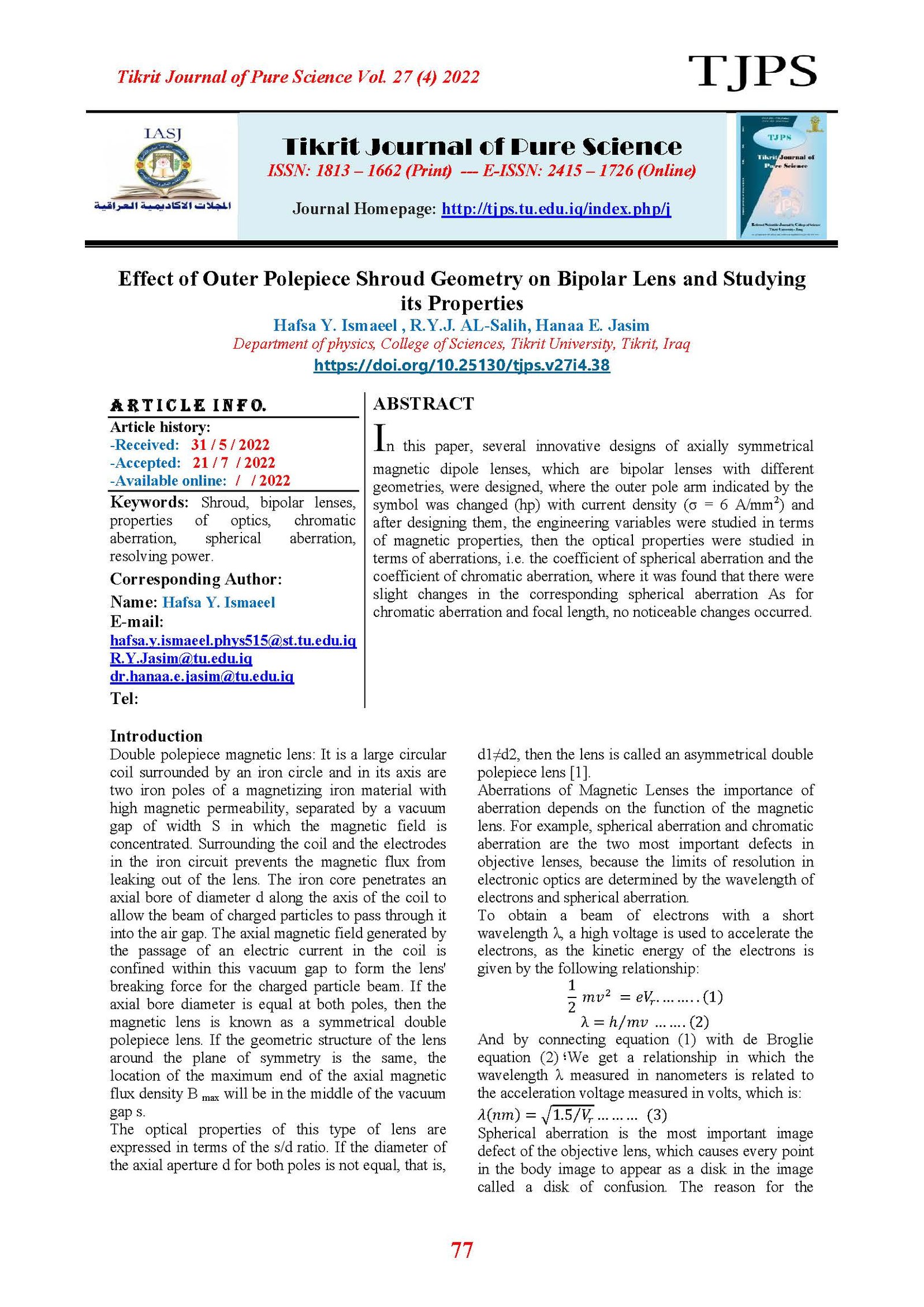Effect of Outer Polepiece Shroud Geometry on Bipolar Lens and Studying its Properties
Main Article Content
Abstract
In this paper, several innovative designs of axially symmetrical magnetic dipole lenses, which are bipolar lenses with different geometries, were designed, where the outer pole arm indicated by the symbol was changed (hp) with current density (σ = 6 A/mm2) and after designing them, the engineering variables were studied in terms of magnetic properties, then the optical properties were studied in terms of aberrations, i.e. the coefficient of spherical aberration and the coefficient of chromatic aberration, where it was found that there were slight changes in the corresponding spherical aberration As for chromatic aberration and focal length, no noticeable changes occurred.
Article Details

This work is licensed under a Creative Commons Attribution 4.0 International License.
Tikrit Journal of Pure Science is licensed under the Creative Commons Attribution 4.0 International License, which allows users to copy, create extracts, abstracts, and new works from the article, alter and revise the article, and make commercial use of the article (including reuse and/or resale of the article by commercial entities), provided the user gives appropriate credit (with a link to the formal publication through the relevant DOI), provides a link to the license, indicates if changes were made, and the licensor is not represented as endorsing the use made of the work. The authors hold the copyright for their published work on the Tikrit J. Pure Sci. website, while Tikrit J. Pure Sci. is responsible for appreciate citation of their work, which is released under CC-BY-4.0, enabling the unrestricted use, distribution, and reproduction of an article in any medium, provided that the original work is properly cited.
References
[1] Liebmann, G. (1951)., "The Symmetrical Magnetic Electron Microscope Objective Lens With Lowest Spherical Aberration"., Proc. Phys. Soc. B, 64, 972-977.
[2] Hall, C. E. (1966). “Introduction of Electron Microscopy”. 2nd ed. (MC. Grown-Hill).
[3] Hawkes, P. W. (1982)., "Magnetic Electron Lenses", (Spreinger-Verlag, Berlin).
[4] T. Mohsen, Q. Ahmed, Design and Study of the Op-tical Properties of Electromagnetic Lenses Dual-polar an-alog using the program (EOD), JUB. 25 (2017) 1991–1997.
[5] N. Numan, Theoretical Study of Geometrical Proper-ties and Aberrations in Doublet Magnet Lenses, JUBES. 26 (2018) 178–187.
https://www.journalofbabylon.com/index.php/JUBES/arti-cle/view/1596.
[6] M. Al-Shamma, M. Al-Khashab, Improvement of the optical performance of the geometrical parameters of snor-kel magnetic lens, Raf.J.Sci. 28 (2019) 85–97.
[7] Lencova B. (2001) Recent Development in Methods for Electron Optical Computation Microscopy. Barcelona 93, 432-439.
[8] Al-Salih, R. Y. J., Al-Abdulla, A. I., & Alkattan, E. M. A. (2022). Program for Calculating the Axial Magnetic Field Distribution of Magnetic Lenses Using Finite Element Method. Jordan Journal of Physics, vol.16 , No.5 .
[9] Al-Salih, R. Y. J., Al-Abdulla, A. I., & Alkattan, E. M. A. (2021). Simple program for computing objective optical properties of magnetic lenses. International Journal of Computer Applications in Technology, 66(3-4), 254-259.
[10] Wiedemann, H. (2007). Particle acelerator physics, Springer.
[11] Kellogg, M., Eisenstein, J., Pfeiffer, L. N., & West, K. W. (2004). Vanishing Hall resistance at high magnetic field in a double-layer two-dimensional electron system. Physical review letters, 93(3), 036801.
